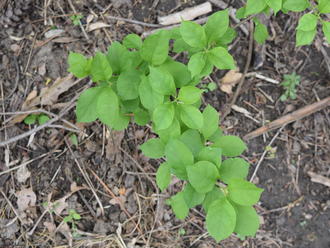Observation 136
Date observed: Apr. 22, 2019
How to Report Number - Close
The number field is an optional field to count the number of distinct individual plants you observed. It is a minimum, meaning that if you report 3 plants, this means you observed at least three plants. You can change this to any number such that you are sure there are at least that number of plants.
For plants that reproduce vegetatively, such as a patch of goldenrod, aster, or milkweed that germinated from a single seed, but now have multiple stems, count this as only one plant.
If you are not sure whether or not plants are from vegetative reproduction, or if you do not want to count plants, just leave this as the default value of 1. Because it is a minimum count, there is no harm in leaving this field as 1 no matter how many plants are present.
Organism Type Categories - Close
This field helps us track which plants are cultivars vs. wild type plants. If not familiar with how to distinguish cultivars from wild type plants of this species, select "Unsure".
Wild Type - Plant has a form or phenotype within the range of wild plants of this species. It is not visibly or obviously a cultivar.
Intermediate - A plant that has clearly descended from, and retained some of the characteristics of cultivars, but has begun to revert back to a more wild form. Common in first generations of plants descended from cultivars.
Cultivar - Cultivars or named varieties of plants with observable characteristics or phenotype outside the range of those that occur in the wild.
Unsure - Select this if you are unsure whether a plant is a wild type or cultivar.
Origin Categories - Close
This field helps us track which plants were planted or seeded by humans, vs. ones that came up on their own through natural processes. If you do not know the history of a site, or cannot discern whether or not plants are planted or seeded, select "Unsure".
Volunteer (Wild) - Plants that come up on their own from seeds distributed by natural processes (wind, animals, or unintentional acts of humans.) This is the category to use for weeds and fully wild plants.
Seeded - Humans intentionally planted or distributed the seeds of this plant, but it germinated on its own. This plant was not planted as a whole plant.
Planted - Something directly planted, after germination, by humans. This includes most plants in flower beds, street trees, and landscaping plants.
Volunteer or Seeded - Use this if you are sure that a plant germinated on its own and has not been moved or transplanted, but you are unsure whether the seeds were planted or put down by people, or distributed by natural processes.
Seeded or Planted - Use if you know a plant was put here by people, but are unsure of whether it was transplanted, or whether people planted seeds which later germinated on their own.
Unsure - Select this if you are unsure whether a plant was planted by humans, seeded by humans, or came up on its own.
Species in this observation
| Scientific Name | Common Name | # (at least) (?) | Type (?) | Origin (?) |
| Alliaria petiolata | Garlic Mustard | 1 | Wild Type | Volunteer (Wild) |
| Arctium minus | Lesser Burdock | 1 | Unspecified | Unspecified |





